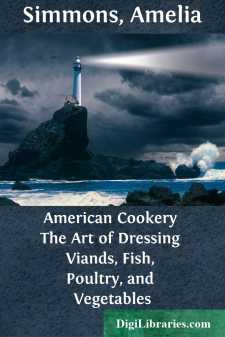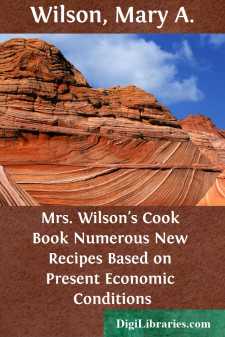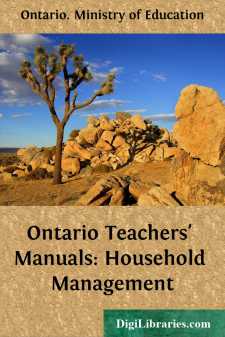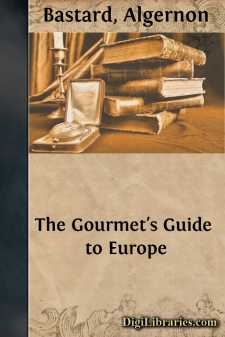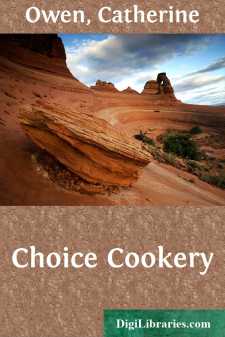Cooking
- General 70
- History 1
- Reference 10
- Regional & Ethnic 3
- Vegetarian 10
Cooking Books
Sort by:
by:
Amelia Simmons
PREFACE. As this treatise is calculated for the improvement of the rising generation of Females in America, the Lady of fashion and fortune will not be displeased, if many hints are suggested for the more general and universal knowledge of those females in this country, who by the loss of their parents, or other unfortunate circumstances, are reduced to the necessity of going into families in the line...
more...
by:
Mary A. Wilson
MRS. WILSON'S COOK BOOK Bread, the staff of life, must be palatable and good if we are to be satisfied with it when we eat. Can you think of anything that will spoil a meal more quickly than poor, over moist, doughy or heavy bread? Bread may truly be called the staff of life, as it will maintain life longer than any other single food. Yet many women think bread-making is a simple task; that the...
more...
CHAPTER I. THE MISTRESS. "Strength, and honour are her clothing; and she shall rejoice in time to come. She openeth her mouth with wisdom; and in her tongue is the law of kindness. She looketh well to the ways of her household; and eateth not the bread of idleness. Her children arise up, and call her blessed; her husband also, and he praiseth her."вÐâProverbs, xxxi. 25-28. I. AS WITH...
more...
by:
Alice Bradley
INTRODUCTION Meals of many courses are neither practical nor popular with the modern hostess. For a company luncheon or supper it is not necessary to serve more than a hot dish, a salad, a biscuit or sandwich, a dessert and a beverage. A first course and a relish may be provided if desired. SUNDAY NIGHT SUPPERS The following menus were arranged especially as Sunday night suppers, but they are equally...
more...
CHAPTER I INTRODUCTIONUntila comparatively recent period, education was regarded mainly as a means of training the intellect, but this conception of education is now considered incomplete and inadequate. Our ideas of the purpose of schools are becoming broader, and we have decided that not only the mental nature, but all the child's activities and interests, should be given direction by means of...
more...
MEATS AND POULTRY. To Boil Fresh Meat. In boiling fresh meat, care is necessary to have the water boiling all the time it is in the pot; if the pot is not well scummed, the appearance of the meat will be spoiled. Mutton and beef are preferred, by some, a little rare; but pork and veal should always be well done. A round of beef that is stuffed, will take more than three hours to boil, and if not...
more...
by:
Joe Tilden
SOUPS AND CHOWDERS [Illustration] Onion Soup Place six ounces of butter in a large saucepan over the fire, and stir into it four large white onions cut up, not sliced. Stew this very slowly for one hour, stirring frequently to prevent its scorching. Add salt, pepper, cayenne, and about one quart of stock, and cook one hour longer. Then stir into the mixture one and a half cups of milk and simmer for a...
more...
by:
Eliza Leslie
SOUPS. GENERAL REMARKS. Always use soft water for making soup, and be careful to proportion the quantity of water to that of the meat. Somewhat less than a quart of water to a pound of meat, is a good rule for common soups. Rich soups, intended for company, may have a still smaller allowance of water. Soup should always be made entirely of fresh meat that has not been previously cooked. An exception to...
more...
by:
Algernon Bastard
PREFACE Often enough, staying in a hotel in a foreign town, I have wished to sally forth and to dine or breakfast at the typical restaurant of the place, should there be one. Almost invariably I have found great difficulty in obtaining any information regarding any such restaurant. The proprietor of the caravanserai at which one is staying may admit vaguely that there are eating-houses in the town, but...
more...
by:
Catherine Owen
INTRODUCTION. By choice cookery is meant exactly what the words imply. There will be no attempt to teach family or inexpensive cooking, those branches of domestic economy having been so excellently treated by capable hands already. It may be said en passant, however, that even choice cooking is not necessarily expensive. Many dishes cost little for the materials, but owe their daintiness and...
more...


